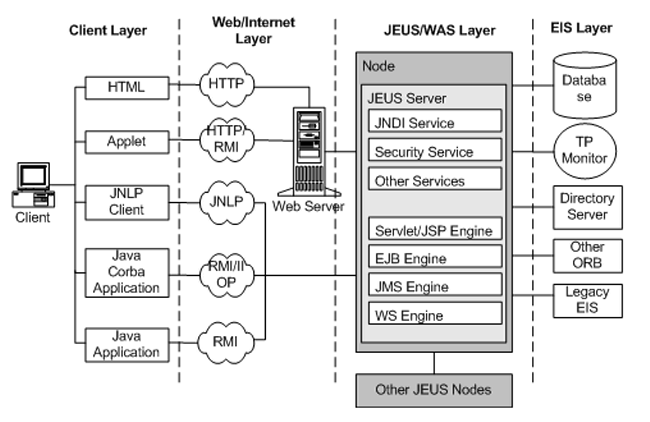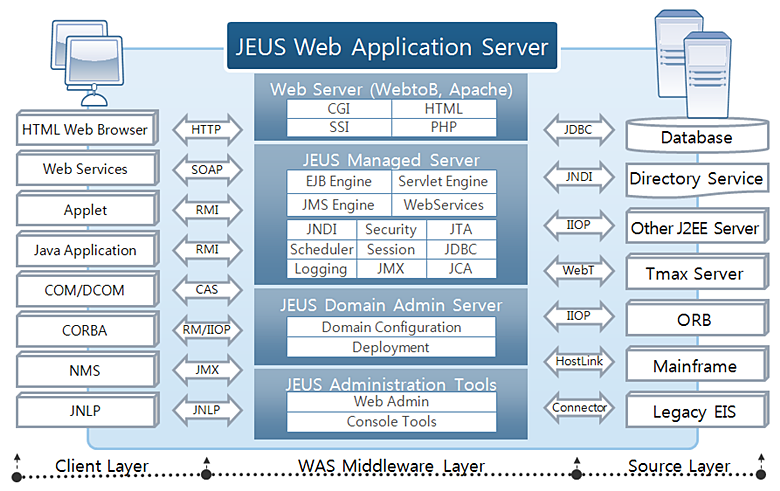Table of Contents
This chapter describes the basics of JEUS and Java EE specification. It also explains the concepts of a JEUS system, its components, and features of each edition.
Java Enterprise User Solution (JEUS) provides a platform for the development, operation, and execution of applications in a Web environment. It also supports Java-based Web application services and their management. JEUS provides a platform and the following components that are required to execute Java EE applications.
-
EJB containers
-
Web containers (JSPs/Servlet engines)
-
Security modules
-
Naming servers
-
Transaction managers
-
JDBC connection pools
-
Session managers
Java EE
JEUS conforms to Oracle's Java Enterprise Edition specification, and is Java EE 7 certified. JEUS supports all of the listed technologies in the following quotes from Oracle website.
"The Java Platform, Enterprise Edition (Java EE) defines the standard for developing multitier enterprise applications. The Java EE platform simplifies enterprise applications by basing them on standardized, modular components, by providing a complete set of services to those components, and by handling many details of application behavior automatically, without complex programming."
"The primary technologies in Java EE are: Enterprise JavaBeans™ (EJBs™), JavaServer Pages™ (JSPs™), Java Servlets, the Java Naming and Directory Interface™ (JNDI™), the Java Transaction API (JTA), CORBA, and the JDBC™ data access API."
Note
For more information about Java EE, refer to Oracle website. (http://www.oracle.com/technetwork/java/javaee/overview/index.html)
The following table lists the Java EE features that are implemented in JEUS 8.
| Spec | JEUS 8 |
|---|---|
| J2EE | Java EE 7 |
| WebServer | WebtoB 5.0 |
| HTTP | 1.0/1.1/2.0 |
| CGI | 1.1 |
| PHP | 3.x/4.x/5.x |
| SSL | /ssl3/tls1 |
| WebSocket | 1.0 |
| Java API for JSON Processing | |
| Batch Application for the Java Platform | |
| Concurrency Utilities for Java EE | 1.0 |
| EJB | 3.2 |
| RMI-IIOP | Supported |
| JAF | 1.1 |
| EJB to CORBA Mapping | 1.1 |
| JCA | 1.7 |
| JMS | 2.0 |
| Common Annotations for the Java Platform | 1.2 |
| JPA | 2.1 |
| JavaMail API | 1.5 |
| JTA | 1.2 |
| JTS | 1.0 |
| JNDI | 1.2.1 |
| CDI | 1.1 |
| Bean Validation | 1.1 |
| Managed Beans | 1.0 |
| Interceptors | 1.2 |
| JSP | 2.3 |
| Servlet | 3.1 |
| JSF | 2.2 |
| JSTL | 1.2 |
| XSLT | 1.0 |
| JDBC | 4.0 |
| IBM MQ | Supported |
| Sonic MQ | Supported |
| J2EE Management | 1.1 |
| J2EE Deployment API | 1.2 |
| JAAS | 1.0.1 |
| JACC | 1.5 |
| JASPIC | 1.1 |
| JAXP | (Included in JDK 7) |
| StAX | (Included in JDK 7) |
| JAXB | 2.2 |
| SAAJ | 1.3 |
| Implementing Enterprise Web Services | 1.3 |
| Web Service Metadata | 2.1 |
| JAX-RPC | 1.1 |
| JAX-WS | 2.2 |
| JAX-RS | 2.0 |
| JAXR | 1.0 |
| UDDI | 2.0/3.0 |
| SOAP | 1.1/1.2 |
| WSDL | 1.1 |
| WS-I Basic Profile | 1.1 |
| WS-Policy | 1.5 |
| WS-Policy Attachment | 1.5 |
| WS-Addressing | 1.0 |
| WS-Security | 1.1 |
| WS-Security Policy | 1.2 |
| WS-Trust | 1.4 |
| WS-Secure Conversation | 1.4 |
| WS-Reliable Messaging | 1.2 |
| WS-AtomicTransaction | 1.2 |
| WS-Coordination | 1.2 |
| OTS | Supported |
| Java IDL API | Supported |
| IDE Tool | Not supported |
| GUI Tool | Not supported |
| Web Tool | WebAdmin |
| Monitoring Tool | Console Tool, WebAdmin |
| JDK | 7 (Certified) |
Note
1.For more information about the specifications, refer to http://www.oracle.com/technetwork/java/javaee/tech/index.html.
2. Some editions of JEUS may not implement all of the features. For more information, refer to the documents for each JEUS edition.
The following figure shows how JEUS integrates with other Web servers or DBMSs to provide enterprise application solutions.
The following are the four layers shown in the previous figure.
-
Consists of Java applications and native applications. End users use various clients to access WAS services, and the clients use various protocols to access WAS services.
-
Consists of Web server and protocols used by clients and WAS. This layer deals with static contents and load balancing.
-
Consists of Java-based middleware and deals with requests from the Web and client layers.
-
Consists of data and existing legacy services. WAS interoperates with legacy services through various mechanisms such as JDBC, directory services, and Java EE connector.
JEUS is made up of various components. These components operate differently depending on which communication technologies they use to communicate with clients, data storage devices, and JEUS, as shown in the following figure.
The client layer in the previous figure shows a diverse set of client applications and communication protocols. The source layer shows various types of data storage devices. The WAS middleware layer contains JEUS and Web server. The Web server connects with client applications and is tightly coupled with the Web application server. The Web gateway (WebT) connects the Web application server to the TP-Monitor (Tmax server), and the mainframe gateway (Host-Link) provides connection between a mainframe system and TP-Monitor.
Each layer is explained in more detail in the following sections.
The client layer consists of remote and local applications that use JEUS. It contains the following components.
| Client Layer | Description |
|---|---|
| Web Browser | The most common client application is a standard web browser that sends requests to a JEUS Servlet Engine and WebtoB Light Web server to retrieve HTML contents. The communication protocol used is HTTP. |
| Web Services | Provides Web service implementations. |
| Applet | Provides a special applet container that can access JEUS's components. |
| Java Application | Standalone Java applications are executed by using RMIs within client containers provided by JEUS. Clients are called application clients in the Java EE specification. |
| COM/DCOM | EJBs can be invoked as COM objects in Microsoft Windows. |
| CORBA | CORBA applications can use JEUS via RMI/IIOP. |
| NMS | Network Management System manages and uses JEUS via JMX. |
| JNLP | Java Network Launching Protocol (JNLP) clients are supported in JEUS 8. |
The JEUS WAS layer in [Figure 1.2] corresponds to JEUS 8. Its components are as follows:
-
JEUS Domain Administration Server (DAS)
Each domain must have a special server called a Domain Administration Server (hereafter DAS). The configurations that define the relationship between servers of a domain, and applications and resources in the domain are centrally managed by DAS. DAS controls and monitors servers by communicating with the management tools, WebAdmin and jeusadmin.
Service Description Domain Configuration Manages domain configurations. Application Management Manages domain applications. Administration Centrally monitors and controls all domain servers, services, applications, and resources by using WebAdmin and jeusadmin. -
JEUS Managed Server (MS)
An MS contains several types of engines configured within a JEUS system. There are the following four engine types.
Engine / Service Description EJB Engine Runs EJB applications. Servlet Engine Web container that handles both JSP/Servlet applications and static contents like HTML. JMS Engine Supports JMS structures. Web Services Engine JEUS Web server that acts as the front end of the servlet engine. JNDI Service Naming system. Security Service Handles authentication and authority. JTA Provides complete transactions for various applications running on Web application servers. Scheduler Supports timers that trigger an event at a predefined time. Session Manager Reliably stores client session information when clustering is needed. JDBC Configurable database connection pool. Logging Stores and records jobs that have been executed on JEUS. JMX Allows NMS/JMX clients to manage JEUS. JCA JCA stands for Java EE Connector Architecture. JCA allows any legacy Enterprise Application Integration (EAI) solution to integrate with a legacy EIS if the EAI solution supports JCA. -
Web Server (WebtoB or Apache)
The Web server transfers static contents such as HTML and dynamic contents such as CGI. It acts as the front end of the servlet engine. WebtoB is available in two versions, WebtoB, which completely supports all Web server features, and JEUS Web Server, which partially supports the features.
JEUS Web server comes with JEUS but not with WebtoB. As an alternative, open-source web server Apache may be used with JEUS.
-
JEUS Administration Tools
The following two main management tools are available for use.
Tool Description WebAdmin Web tool that can be used in a Web browser to manage JEUS components and to package and configure applications. Console Tool (jeusadmin) Enables console access to the features available from GUI. This is used when GUI is unavailable.
The source layer shown in[Figure 1.2] shows the back-end resources and data storage used by JEUS system. The following are the components.
| Source Layer | Description |
|---|---|
| Database | Can be accessed by JEUS through JDBC. |
| Directory Service | JNDI is used to access services like LDAP. |
| Other Java EE Server | JEUS interoperates with Java EE Servers from other vendors. |
| Tmax Server | TmaxSoft's TP-monitor. WebT API library is used to access JEUS or Tmax. |
| ORB | Can be referenced by using IIOP (Internet Inter-ORB Protocol). |
| Mainframe | Accessed by using Host-Link or Java EE connector products. |
| Legacy EIS | Supports JCA and interoperates with JEUS. |
Interoperability refers to the ability of two or more systems, such as computers, communication devices, networks, software, and other information technology components, to interact with one another and exchange data according to a prescribed method in order to achieve predictable results (ISO ITC-215).
JEUS supports communication protocols and technologies such as Web services, JBuilder Bridge, JNLP, and RMI-IIOP. The following are the modules provided for JEUS interoperability.
| Module | Description |
|---|---|
| RMI-IIOP | RMI technology that uses Internet Inter-ORB Protocol (IIOP) and enables distributed CORBA computing jobs in Java. |
| JEUS | Interoperates with other vendors' Web applications and services. |
| WebT | Provides a connection between TP-Monitor and JEUS. |
| Host-Link | Adapter module that enables clients to use services that are running on an EIS. |
| JCA | Enables JEUS and JEUS clients to virtually interoperate with any legacy EIS. |
The following table shows the main features of each JEUS 8 edition.
| Edition | Main Features |
|---|---|
| JEUS Standard Edition |
|
| JEUS Enterprise Edition |
|
Note
1. All features of the previous table are covered in the JEUS manuals. Refer to this table to check whether the features described in each guide are available for use. JEUS includes a Trial license by default.
2. A Cloud license is provided for each of Standard Edition and Enterprise Edition.

